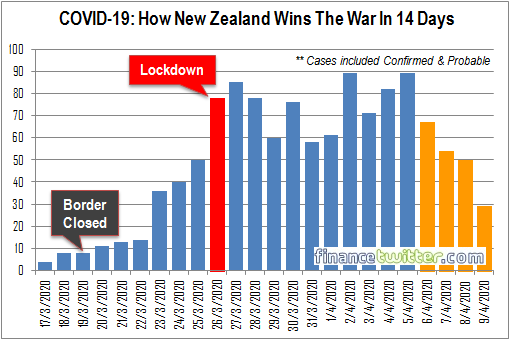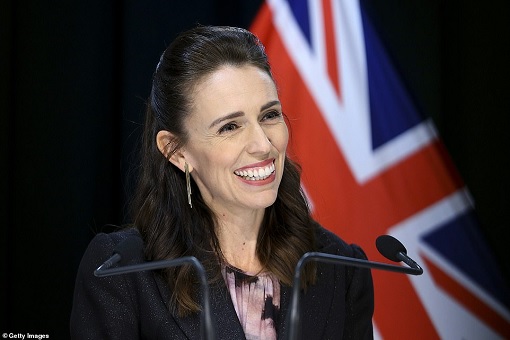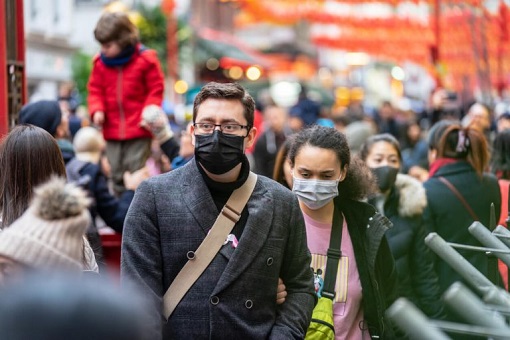On Thursday (March 9), Kiwis were delighted as the number of Coronavirus cases continue to drop – only 29 new cases. New Zealand’s total cases are now 1,239, including only one death. In essence, the deaths per 1-million population in the country was only 0.2 – a remarkable achievement. In comparison, Spain registered 326 deaths for every 1-million population.
The country confirmed its first case on February 28 and shut its borders on March 19, essentially banning foreigners from entering the country. All international visitors or tourists were given the instruction to self-quarantine for 14 days. First announced on March 23, New Zealand completed its “level-4” nationwide lockdown by March 26. Schools and non-essential services were shut down.
Under the 1-month of level-4 lockdown, Kiwis cannot leave their homes except for essential supplies such as food or medicine, but they could do outdoor activities like gardening or take a brief walk or short exercise in their local area. They can only interact with those in their household “bubble,” and must practise “social distancing” – at least 2 metres (6.5 feet) from others.

Now, after about 14 days of the lockdown, it appears New Zealand is winning its war against the COVID-19 virus. In fact, the country has seen a stunning decline in new confirm cases for the last 4 days consecutively, plunging from 89 cases (April 5) to only 29 cases (April 9). This has led to speculations that the lockdown may be lifted very soon.
However, Prime Minister Jacinda Ardern prefers to play safe. She said that citizens who are returning to the country will be required to spend 2 weeks at 14 Auckland hotels, rather than self-isolating at home – suggesting the war has turned to tightening its border. The government said it will only decide whether to end or relax the lockdown on April 20, two days before its scheduled end date.
So, how did New Zealand manage to do something that many other countries wish they could do, including the U.S. and UK? PM Jacinda, the country’s youngest prime minister, had acted decisively from the beginning. New Zealand had only 6 confirmed cases – and zero deaths – when she announced on March 14 a ban on foreigners entering the country.

Even though New Zealand had 102 Coronavirus cases only at the time she announced a shutdown on March 23, she was not complacent but, instead talked about the potential fatalities of “tens of thousands” of New Zealanders. The country’s cases peaked on March 27 with 85 confirmed new Covid-19 cases, bringing the total to 368.
It registered 89 cases on April 2 and April 5, but those cases consisted of confirmed as well as “probable”, the clearest sign that the government has been incredibly transparent from the beginning. The government also quickly announced NZ$12.1 billion to support businesses, increase benefits for seniors and low-income families, and pay people who can’t work because of self-isolation.
The package may not sound a lot, but the scheme was massive enough to support employment of most-affected firms with a subsidy of NZ$585 per week per full-time worker (NZ$350 for part-time workers) for up to 12 weeks. The package was roughly equivalent to 4% of New Zealand’s GDP (annual gross domestic product). In comparison, Australia’s package was less than 1% of its GDP.

Heck, the Kiwi government was so serious about fighting the Coronavirus that its Health Minister Dr David Clark has been demoted after he ignored national lockdown rules and drove his family to a beach 20km from his home. The minister admitted his mistake – even called himself an “idiot” – and had offered his resignation to PM Ardern, who did not accept it.
Of course, New Zealand’s small population of 5-million and its advantage of being an island far from most other countries do help in a way to fight the pathogen. But without good leadership and the acknowledgement of science, the country could end up like Italy or even the U.S. As of April 9, it has conducted 51,165 tests or 10,610 tests per 1-million population, more than the U.S., UK, Spain and France.
In addition, as part of the national emergency reserve, New Zealand has 18 million masks in reserve with 80,000 more being made a day to cater for its 5-million populations. In a strategic move, Prime Minister Jacinda Ardern deliberately posted a video on Instagram showing masks being made in a factory in Whanganui, a city on the North Island of New Zealand.

Assuring the Kiwis, PM Jacinda said – “This is a factory in Whanganui churning out face masks to help keep our essential service workers safe. They can produce at least 80,000 masks a day and with new machinery due in the coming weeks and months they will be able to double production. Add to that the 18 million masks we already have in our national reserves and we’re well stocked.”
In comparison, the United States, with its 330 million people, has a national stockpile of only 12 million N95 masks and 30 million surgical masks. Now that the country has more than 100,000 confirmed Coronavirus cases, the U.S. Department of Health and Human Services said that over the next 18 months it aims to buy 500 million masks for the Strategic National Stockpile. - financetwitter


No comments:
Post a Comment
Note: Only a member of this blog may post a comment.